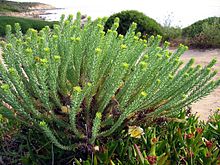| Euphorbia paralias | |
|---|---|

| |
| Sea Spurge in La Revellata, Corsica | |
| Scientific classification | |
| Kingdom: | Plantae |
| Clade: | Tracheophytes |
| Clade: | Angiosperms |
| Clade: | Eudicots |
| Clade: | Rosids |
| Order: | Malpighiales |
| Family: | Euphorbiaceae |
| Genus: | Euphorbia |
| Species: | E. paralias |
| Binomial name | |
| Euphorbia paralias L. | |
Euphorbia paralias, the Sea Spurge, is a species of flowering plant in the family Euphorbiaceae, native to Europe, northern Africa and western Asia.
The species is widely naturalised in Australia. It invades coastal areas, displacing local species and colonising open sand areas favoured by certain nesting birds. Major eradication programs have been undertaken in some areas, for example by Sea Spurge Remote Area Teams in Tasmania, with great success.
Description
E. paralias is an erect, glaucous, perennial plant, growing up to 70 centimetres (28 in) tall. It has many stems, dividing into 3–5 fertile branches, each branching further. The cauline leaves (arising from the stem, without a stalk) are crowded, overlapping, elliptic-ovate (ovate toward the top of the stems), fleshy and 5–20 millimetres (0.2–0.8 in) long. Leaves on fertile branches are circular-rhombic or reniform. The flower head is on a solitary cyathium, found in upper forks or at the apex, surrounded by bell-shaped bracts. Female flowers have styles that divide into two short stigmas, flowering from September to May. The fruit is a capsule, flattened from above or nearly spherical, with deep furrows, and wrinkled on keels. Seeds are ovoid, pale-grey and smooth. There is a kidney-shaped fleshy outgrowth from the seed coat.
Habitat
E. paralias inhabits sandy sea-shores.
References

- David Chapman (2008). Exploring the Cornish Coast. Penzance: Alison Hodge. p. 45. ISBN 9780906720561.
- "Euphorbia paralias". Germplasm Resources Information Network. Agricultural Research Service, United States Department of Agriculture. Retrieved 2008-12-23.
- ^ James, T.A. & G.J. Harden. "Euphorbia paralias". PlantNET – New South Wales Flora Online. Royal Botanic Gardens & Domain Trust, Sydney Australia. Retrieved 2008-12-23.
- "Have you seen this beach weed?". Department of Primary Industries, Water and Environment (Tasmania). Archived from the original on 22 April 2011. Retrieved 30 May 2011.
- "Wildcare SPRATS volunteer weed eradication project". Parks and Wildlife Service Tasmania. Archived from the original on 2017-12-07. Retrieved 2023-11-24.
- Boyce, Lauran; Buckeridge, John (2018). The terrestrial plants of the Rickett's Point Urban Sanctuary : Beaumaris Vic 3193. Beaumaris, Victoria: Greypath Productions. p. 73. ISBN 978-1760019716. Retrieved 7 November 2020.
- Tutin. Flora Europaea, vol. 2.
| Taxon identifiers | |
|---|---|
| Euphorbia paralias |
|
This Euphorbia-related article is a stub. You can help Misplaced Pages by expanding it. |